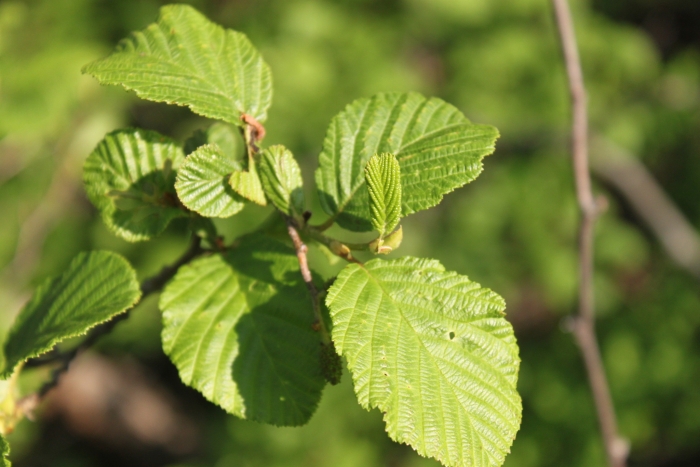Speckled Alder
(Alnus incana subsp. rugosa)
Speckled Alder (Alnus incana subsp. rugosa)
/
/

Étienne Lacroix-Carignan
Public Domain
Image By:
Étienne Lacroix-Carignan
Recorded By:
Copyright:
Public Domain
Copyright Notice:
Photo by: Étienne Lacroix-Carignan | License Type: Public Domain | License URL: http://creativecommons.org/publicdomain/zero/1.0/ | Rights Holder: Étienne Lacroix-Carignan | Publisher: iNaturalist | Date Created: 2019-06-30T19:30:13-07:00 |














































Estimated Native Range
Summary
Alnus incana subsp. rugosa, commonly known as Speckled Alder, is a deciduous shrub or small tree native to wetlands, including swamps, stream banks, and moist forested areas in the Northeastern United States and Eastern Canada. It typically grows to a height of 16 feet (5 meters) and a width of 15-25 feet (5-8 meters), with a multi-stemmed, clumping habit. The Speckled Alder is characterized by its gray-brown bark speckled with white lenticels, and its catkins which appear before the leaves in early spring. The male catkins are long and yellowish-green, while the female catkins are shorter and reddish-green, maturing into small, woody cones that persist through winter. This species is particularly noted for its ability to fix nitrogen in the soil through a symbiotic relationship with bacteria.
The Speckled Alder is valued for its adaptability to wet conditions and is often used for streambank stabilization and wetland restoration. It is also planted for wildlife habitat enhancement, as its seeds provide food for birds and other animals. In the garden, it can be used as a natural screen or in a rain garden. This alder prefers full sun to part shade and medium to wet soils with good drainage. While it is generally low-maintenance, it can be susceptible to leaf spot diseases and alder blight. It is not typically invasive but can spread by suckering, which may require management in a garden setting.CC BY-SA 4.0
The Speckled Alder is valued for its adaptability to wet conditions and is often used for streambank stabilization and wetland restoration. It is also planted for wildlife habitat enhancement, as its seeds provide food for birds and other animals. In the garden, it can be used as a natural screen or in a rain garden. This alder prefers full sun to part shade and medium to wet soils with good drainage. While it is generally low-maintenance, it can be susceptible to leaf spot diseases and alder blight. It is not typically invasive but can spread by suckering, which may require management in a garden setting.CC BY-SA 4.0
Plant Description
- Plant Type: Tree, Shrub
- Height: 15-25 feet
- Width: 15-25 feet
- Growth Rate: Moderate
- Flower Color: N/A
- Flowering Season: Spring
- Leaf Retention: Deciduous
Growth Requirements
- Sun: Full Sun, Part Shade
- Water: Medium
- Drainage: Medium, Fast
Common Uses
Bee Garden, Bird Garden, Butterfly Garden, Erosion Control, Low Maintenance, Rabbit Resistant, Water Garden
Natural Habitat
native to wetlands, including swamps, stream banks, and moist forested areas in the Northeastern United States and Eastern Canada
Other Names
Common Names: Aulne Blanchâtre, Aulne Blanc Rugueux, Aulne Hâtif, Aulne Rugueux, Vergne, Verne, Hasselal
Scientific Names: , Alnus incana subsp. rugosa, Alnus rugosa, Alnus americana, Alnus rugosa var. americana, Alnus rugosa f. hypomalaca, Alnus incana var. americana, Alnus rugosa f. emersoniana, Alnus glutinosa subsp. rugosa, Alnus incana f. tomophylla
GBIF Accepted Name: Alnus incana subsp. rugosa (Du Roi) R.T.Clausen